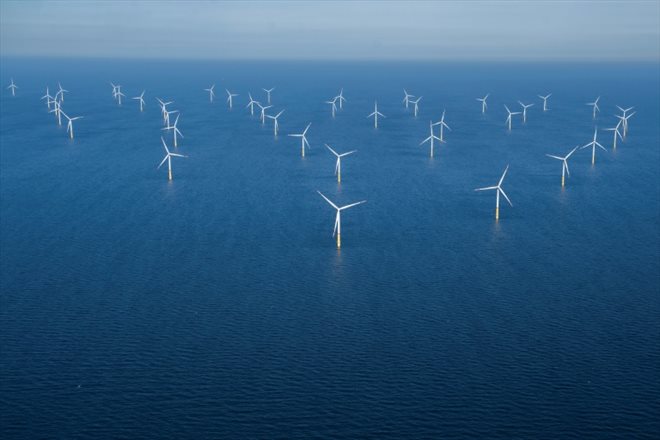A wind farm in the Baltic Sea, northeast of the island of Rügen, June 16, 2022 in Germany (AFP/Archives/FRED TANNEAU)
The EU must increase by ten its current rate of deployment of offshore wind turbines to meet the objective set for 2030, the European Commission said on Tuesday, which wishes to further facilitate the authorization procedures and calls for tenders for projects.
At the end of 2022, the Twenty-Seven totaled 16.3 gigawatts of offshore wind capacity, while they have committed to collectively reaching 111 GW by the end of the decade.
This means that they should now install almost 12 GW per year… or ten times more than the 1.2 GW built last year, explained the European executive.
A considerable challenge: wind power is going through a storm, weighed down by soaring interest rates which complicate financing, inflation in raw materials which is causing costs to explode, and tensions over the supply of key components ( nacelles, cables, turbines, etc.) with Chinese manufacturers in ambush.
To reach 42.5% renewables in European energy consumption, the total wind capacity installed on sea and on land must increase from 204 GW last year to more than 500 GW in 2030 – an increase of 37 GW/year , compared to only 16 GW in 2022.
– No new legislative proposal –
In mid-September, Commission President Ursula von der Leyen promised “a package of measures” of support.
The “action plan” presented Tuesday by Brussels does not include any new legislative proposals, but a toolbox that EU authorities and member states can mobilize to alleviate “complex” administrative procedures, reduce production prices and increase the competitiveness of manufacturers.
First objective: further accelerate authorization procedures, already facilitated by the recently adopted legislation on renewables, thanks to a Brussels initiative allowing States to process these requests online.
It is up to States to improve the “predictability” of planned projects, with “transparent auction calendars” with better defined criteria and available on a European digital platform, and long-term planning.
On the financing side, the Commission will facilitate access to the European Innovation Fund, while the European Investment Bank (EIB) will provide guarantees to cover private banks granting loans to industrialists — and Brussels “encourages States to make full use of the flexibilities currently provided for in public aid.
Finally, the European executive assures that it will “closely monitor possible unfair commercial practices which benefit producers of wind turbines in third countries” – without explicitly pointing out China.
The proposed actions “will help supply chains in Europe to provide the necessary equipment (…) Everyone must play their role, and these measures must be implemented as quickly as possible, without waiting for new legislation”, commented Giles Dickson, head of the sector federation, WindEurope.
© 2023 AFP
Did you like this article ? Share it with your friends using the buttons below.




